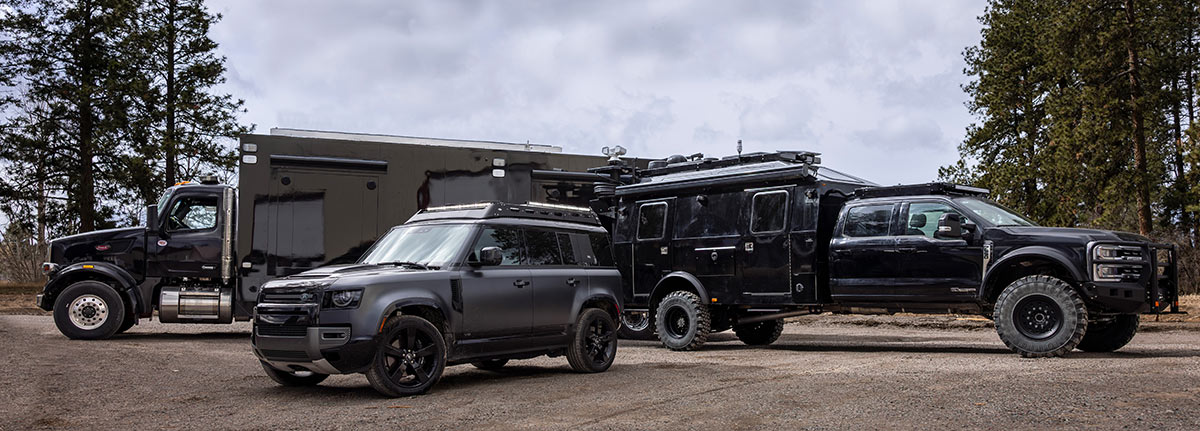Choosing a Connected Mobile Operations Center (CMOC) platform is a big decision. For public safety agencies, emergency managers, utilities, and other organizations that rely on coordinated field operations, the asset you specify will shape your response capabilities for years to come.
Budget is a factor, and it’s tempting to base decisions on something you’ve seen before (maybe a neighboring agency’s rig or a memorable trade show display). But the reality is more complex and the stakes are high. A well-matched platform can expand your team’s capabilities and deliver lasting value, but a mismatch might be underutilized at best, or a liability at worst.
A structured approach thoughtfully evaluates wants versus needs, reduces decision-making friction, and leads to a clear understanding of what capabilities you need for mission success. At Nomad, we’ve worked with hundreds of organizations to navigate this process.
Here are six key decision points when choosing a CMOC platform.
1. Start With Why: Clarify Your Mission
Everything begins with mission clarity. What does the platform need to help you accomplish? For example, a county emergency management department may need to coordinate multi-agency responses to natural disasters. A utility may need a mobile command presence during widespread outages. A federal organization might need a communications hub for exercises or large incidents.
Mobile operations platforms support missions ranging from wildfire response, to environmental monitoring, to continuity of government. Clearly defining the mission helps narrow the options early. A vehicle designed primarily for drone operations will look very different from one that supports incident management or public outreach.
Key takeaway: Start with the “why.” The mission should drive every downstream decision.
2. Understand the Role: How Will the Asset Be Used?
The next step is translating mission into operational use. Who will deploy the vehicle? How frequently? For what types of incidents or events?
A platform that needs to respond quickly and operate in tight spaces might be based on a smaller chassis, or even a trailer towed by an existing fleet vehicle. A platform that serves as a regional coordination hub might be deployed less often but for longer durations, prioritizing space and number (and comfort) of workstations over mobility.
Your platform should fit your mission. Nomad understands that assets are used in vastly different ways: some agencies park their units for weeks at incident bases, while others roll out daily for tactical operations. Factoring in deployment frequency, travel distance, staffing, and typical operating environments ensures the vehicle fits the real-world rhythm of your organization.
Key takeaway: Mission defines purpose, but usage defines practical requirements.
3. Right-Size the Asset: What’s the Form Factor?
With mission and usage defined, the next big decision is form factor. This means selecting the physical platform — whether that’s a trailer, a large self-propelled vehicle, or something in between. Each has advantages and tradeoffs:
- Trailers are cost-effective and can be towed by existing vehicles. They can then be left behind while vehicles are used to position more trailers. Potential downsides? They can require more setup time and require skilled drivers.
- Smaller vehicles like Mercedes-Benz Sprinter vans or truck-based platforms with compact shelters offer agility and rapid deployment, with the tradeoff of limited interior space.
- Large vehicles on commercial chassis provide ample space for staff and technology. But they can be more expensive, and may require CDL drivers or special storage accommodations.
In some cases, a hybrid solution — such as pairing a smaller quick-response unit with a larger regional asset — delivers the best of both worlds.
Key takeaway: Form follows function. The platform should match both the mission and how you plan to operate it.

4. Align Tech with the Mission: What Tools Are Needed?
Technology is at the heart of modern mobile operations. But more isn’t always better. The key is in selecting the right mix of capabilities to support your mission.
Integrating a wide range of solutions, including satellite and cellular connectivity, interoperable radios, drone support, dispatch consoles, audio/video systems, and many other tools should be purposeful, not just impressive.
For example, a platform designed for remote wildfire response may prioritize redundant communications and power generation. One intended for public event security might emphasize real-time video feeds and intelligence collaboration tools. Early discussions with IT and communications stakeholders are crucial to ensure compatibility and scalability.
Key takeaway: Technology should be mission-driven, interoperable, and sustainable.
5. Establish a Realistic Budget: What Are Wants and Needs?
Budgeting is an opportunity to make smart tradeoffs. A clear understanding of priorities helps organizations allocate funds where they’ll deliver the most value.
Nomad works with you based on your budgetary needs and constraints. A wide spectrum of our customers — from small rural agencies to large federal programs—have seen successful projects at many different budget levels. But the most successful share one trait: early, honest conversations about what’s truly essential.
Budgeting isn’t just about acquisition costs. Factor in technology integration, training, and lifecycle costs such as service subscriptions, maintenance, and upgrades. Exploring grant opportunities, cooperative purchasing contracts, and phased acquisitions can also help stretch dollars further.
Key takeaway: A realistic, prioritized budget creates a path to a capable and sustainable platform.
6. Sustainment and Maintenance: What’s the Future Plan?
Finally, think beyond deployment day. How will the asset be stored, maintained, and supported over its service life? Who will be responsible for upkeep, technology updates, and training?
Nomad designs vehicles for durability, but like any specialized equipment, they need regular care from you. A well-planned sustainment strategy ensures your investment continues to deliver value for years. This might include routine maintenance schedules, service agreements, or training additional operators and technicians.
Some organizations build these plans in-house, while others rely on Nomad’s managed support services. Either way, sustainability is key — especially for assets expected to serve for a decade or more.
Key takeaway: A platform is only as effective as the support structure around it.
A Clearer Path Forward
Choosing a mobile operations platform is a complex decision with lasting consequences. But with a clear mission, deep understanding of usage patterns, careful form factor and technology choices, and a realistic budget with planned sustainment, organizations can make confident and informed decisions early in the process.
Nomad GCS has over two decades of experience helping agencies and organizations navigate these choices. By partnering early and thinking holistically, you can ensure your platform is ready to meet today’s needs and tomorrow’s challenges.

